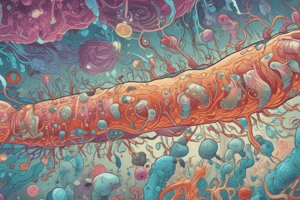Podcast
Questions and Answers
What is a characteristic of bacterial cells?
What is a characteristic of bacterial cells?
- Presence of a true nucleus
- Lack of membrane-bound organelles (correct)
- Large cell size
- Eukaryotic cell structure
What is the function of flagella in bacteria?
What is the function of flagella in bacteria?
- Cell division
- Nutrient uptake
- Movement (correct)
- Cell wall formation
What is the characteristic of Gram-positive bacteria?
What is the characteristic of Gram-positive bacteria?
- Outer membrane
- Thick peptidoglycan layer (correct)
- No cell wall
- Thin peptidoglycan layer
What is the process of bacterial cell division?
What is the process of bacterial cell division?
What is the term for the time required for a bacterial population to double in size?
What is the term for the time required for a bacterial population to double in size?
What is the process by which bacteria break down organic compounds to produce ATP and byproducts?
What is the process by which bacteria break down organic compounds to produce ATP and byproducts?
What is the term for the ability of bacteria to cause disease in hosts?
What is the term for the ability of bacteria to cause disease in hosts?
What is the term for the formation of complex communities by bacteria on surfaces?
What is the term for the formation of complex communities by bacteria on surfaces?
Flashcards are hidden until you start studying
Study Notes
Characteristics of Bacteria
- Prokaryotic cells: Lack true nucleus and membrane-bound organelles
- Single-celled: Typically 0.5-5.0 μm in diameter
- Cell wall: Rigid layer outside cell membrane, provides shape and support
- Flagella: Whip-like structures used for movement
Types of Bacteria
- Gram-positive: Thick peptidoglycan layer in cell wall, stain purple
- Gram-negative: Thin peptidoglycan layer, outer membrane, stain pink
- Spiral (e.g., Spirillum): Helical shape, often found in aquatic environments
- Rod-shaped (e.g., E. coli): Straight or curved, common in soil and human gut
- Spherical (e.g., Staphylococcus): Round shape, often found in skin and respiratory tract
Bacterial Growth and Reproduction
- Binary fission: Cell division, resulting in two identical daughter cells
- Generation time: Time required for population to double in size
- Nutrient requirements: Carbon, nitrogen, phosphorus, and other elements for growth
- Environmental factors: Temperature, pH, oxygen, and light affect growth and survival
Bacterial Metabolism
- Aerobic: Use oxygen for energy production (e.g., Pseudomonas)
- Anaerobic: Do not use oxygen for energy production (e.g., Clostridium)
- Fermentation: Break down organic compounds to produce ATP and byproducts
- Nitrogen fixation: Convert atmospheric nitrogen into usable forms
Interactions with Environment and Hosts
- Symbiotic relationships: Mutualism (e.g., gut bacteria), commensalism, or parasitism
- Pathogenesis: Ability to cause disease in hosts (e.g., Salmonella, Streptococcus)
- Antibiotic resistance: Development of mechanisms to evade antibiotic effects
- Biofilm formation: Adhesion to surfaces, forming complex communities
Characteristics of Bacteria
- Lack true nucleus and membrane-bound organelles, making them prokaryotic cells
- Typically 0.5-5.0 μm in diameter, being single-celled organisms
- Possess a rigid cell wall outside the cell membrane, providing shape and support
- Have whip-like flagella structures used for movement
Types of Bacteria
- Gram-positive bacteria have a thick peptidoglycan layer in their cell wall and stain purple
- Gram-negative bacteria have a thin peptidoglycan layer, an outer membrane, and stain pink
- Spiral bacteria, such as Spirillum, have a helical shape and are often found in aquatic environments
- Rod-shaped bacteria, like E. coli, are straight or curved and common in soil and the human gut
- Spherical bacteria, such as Staphylococcus, have a round shape and are often found in skin and the respiratory tract
Bacterial Growth and Reproduction
- Bacteria reproduce through binary fission, resulting in two identical daughter cells
- The generation time is the time required for the population to double in size
- Bacteria require carbon, nitrogen, phosphorus, and other elements for growth
- Environmental factors like temperature, pH, oxygen, and light affect growth and survival
Bacterial Metabolism
- Aerobic bacteria, such as Pseudomonas, use oxygen for energy production
- Anaerobic bacteria, like Clostridium, do not use oxygen for energy production
- Fermentation is the process of breaking down organic compounds to produce ATP and byproducts
- Nitrogen-fixing bacteria convert atmospheric nitrogen into usable forms
Interactions with Environment and Hosts
- Symbiotic relationships can be mutualistic, commensalistic, or parasitic
- Pathogenic bacteria, like Salmonella and Streptococcus, have the ability to cause disease in hosts
- Antibiotic resistance occurs when bacteria develop mechanisms to evade antibiotic effects
- Biofilm formation involves the adhesion of bacteria to surfaces, forming complex communities
Studying That Suits You
Use AI to generate personalized quizzes and flashcards to suit your learning preferences.



